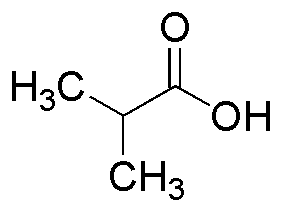Isobutyric acid is widely utilized in research focused on:
- Food Industry: It serves as a flavoring agent and preservative in various food products, enhancing taste while ensuring safety.
- Pharmaceuticals: This compound is used in the synthesis of certain drugs, providing a building block for active pharmaceutical ingredients.
- Agriculture: It acts as a herbicide and plant growth regulator, promoting healthier crop yields and effective weed management.
- Cosmetics: Isobutyric acid is incorporated into personal care products for its emulsifying properties, improving texture and stability.
- Polymer Production: It is utilized in the manufacturing of various polymers, offering enhanced flexibility and durability in materials.
General Information
Properties
Safety and Regulations
Applications
Isobutyric acid is widely utilized in research focused on:
- Food Industry: It serves as a flavoring agent and preservative in various food products, enhancing taste while ensuring safety.
- Pharmaceuticals: This compound is used in the synthesis of certain drugs, providing a building block for active pharmaceutical ingredients.
- Agriculture: It acts as a herbicide and plant growth regulator, promoting healthier crop yields and effective weed management.
- Cosmetics: Isobutyric acid is incorporated into personal care products for its emulsifying properties, improving texture and stability.
- Polymer Production: It is utilized in the manufacturing of various polymers, offering enhanced flexibility and durability in materials.
Documents
Safety Data Sheets (SDS)
The SDS provides comprehensive safety information on handling, storage, and disposal of the product.
Product Specification (PS)
The PS provides a comprehensive breakdown of the product’s properties, including chemical composition, physical state, purity, and storage requirements. It also details acceptable quality ranges and the product's intended applications.
Certificates of Analysis (COA)
Search for Certificates of Analysis (COA) by entering the products Lot Number. Lot and Batch Numbers can be found on a product’s label following the words ‘Lot’ or ‘Batch’.
*Catalog Number
*Lot Number
Certificates Of Origin (COO)
This COO confirms the country where the product was manufactured, and also details the materials and components used in it and whether it is derived from natural, synthetic, or other specific sources. This certificate may be required for customs, trade, and regulatory compliance.
*Catalog Number
*Lot Number
Safety Data Sheets (SDS)
The SDS provides comprehensive safety information on handling, storage, and disposal of the product.
DownloadProduct Specification (PS)
The PS provides a comprehensive breakdown of the product’s properties, including chemical composition, physical state, purity, and storage requirements. It also details acceptable quality ranges and the product's intended applications.
DownloadCertificates of Analysis (COA)
Search for Certificates of Analysis (COA) by entering the products Lot Number. Lot and Batch Numbers can be found on a product’s label following the words ‘Lot’ or ‘Batch’.
*Catalog Number
*Lot Number
Certificates Of Origin (COO)
This COO confirms the country where the product was manufactured, and also details the materials and components used in it and whether it is derived from natural, synthetic, or other specific sources. This certificate may be required for customs, trade, and regulatory compliance.


